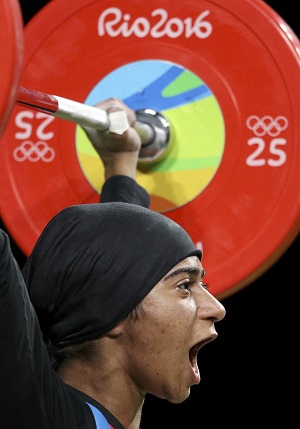As the months leading up to the 2016 Summer Olympics turned into weeks, and as the weeks turned into days, Ibtihaj Muhammad‘s popularity as an athlete and celebrity continued to grow.
The 30-year-old fencer, a three-time All-American at Duke University, went from a newspaper sidebar story to a magazine feature subject. She went from being briefly mentioned on TV to being a guest on nationally syndicated talk shows. She went from being a standout in an obscure sport to a social media star. She went from an inspirational footnote to being named one of TIME magazine’s “100 Most Influential People.”
By the time the Olympic opening ceremony kicked off on August 5 in Rio de Janeiro, Brazil, Muhammad was one of the most talked-about athletes in the world. She reportedly finished second to swimmer Michael Phelps — the most decorated Olympian of all-time and an American sporting legend — in the vote for who would lead the United States delegation during the ceremony as the flag-bearer.
Muhammad, a devout Muslim in a country that is notorious for treating Muslims as an oppressed minority, officially made history on Monday when she became the first U.S. athlete to compete in the Olympics while wearing hijab.
In the opening round of the 32-woman individual sabre fencing competition, Muhammad defeated Olena Kravatska of Ukraine by a score of 15-13.
In the next round, Muhammad was eliminated when she lost 15-12 to Cecilia Berder of France.
“I feel like it’s a blessing to be able to represent so many people who don’t have voices, who don’t speak up,” Muhammad told reporters in Rio. “It’s just been a really remarkable experience.”
The Olympics are not over for Muhammad, though. She will compete in the team sabre event on August 13.
“It represents who she’s been her entire life. Ever since she was a little girl, she never let anything hold her back. She never set limits. She’s always striving to be the very best,” said Muhammad’s brother Qareeb. “Despite the adversity she’s faced; being a Muslim, being an African-American, being a female, she’s still confident in her ability to be successful. She’s my hero.”
***** *****
Another Muslim female made history on Monday in the weightlifting arena.
Ayesha Al Balooshi of the United Arab Emirates became the first athlete from her Muslim-majority country to compete in the Olympics while wearing hijab.
In the women’s 58-kilogram (127-pound) division, the 24-year-old Al Balooshi finished in last place among the 16 competitors. She completed all three of her snatch attempts, with a heaviest lift of 72 kilograms (158.7 pounds). She completed two of her three clean-and-jerk attempts, with a heaviest lift of 90 kilograms (198.4 pounds), and drew a loud ovation for her effort on a failed third attempt of 94 kilograms (207.2 pounds).
Al Balooshi finished with a combined weight of 162 kilograms (357.1 pounds).
The doors to competitive weightlifting were fully opened to Muslim women just five years ago, when the International Weightlifting Federation decided to allow athletes to wear full-body unitards that cover the skin on their arms and legs. Prior to that ruling, the IWF maintained that elbows and knees must be clearly visible so that judges could properly determine whether or not an athlete had completed a lift with those joints locked.
One year later, at the 2012 Summer Olympics in London, Ghada Hassine of Tunisia became the first Muslim female weightlifter to compete in the Olympics wearing the unitard and a hijab headscarf. She finished 10th out of 15 women in the 69-kilogram (152-pound) division, lifting a combined weight of 222 kilograms (489.4 pounds).
Khadija Mohammed became the UAE’s first female Olympic weightlifter at those Games, but she did not wear a full-body unitard or a hijab headscarf. Mohammed finished 12th out of 13 entrants in the 75-kilogram (165-pound) division, lifting a combined weight of 113 kilograms (249.1 pounds).
Categories: NEWS


